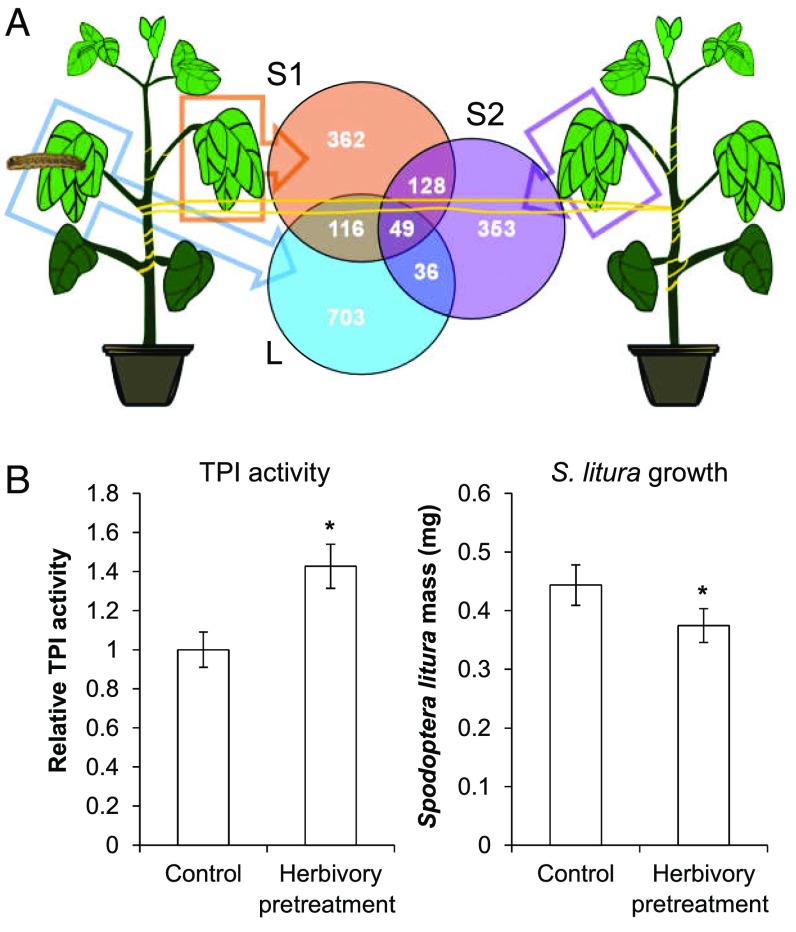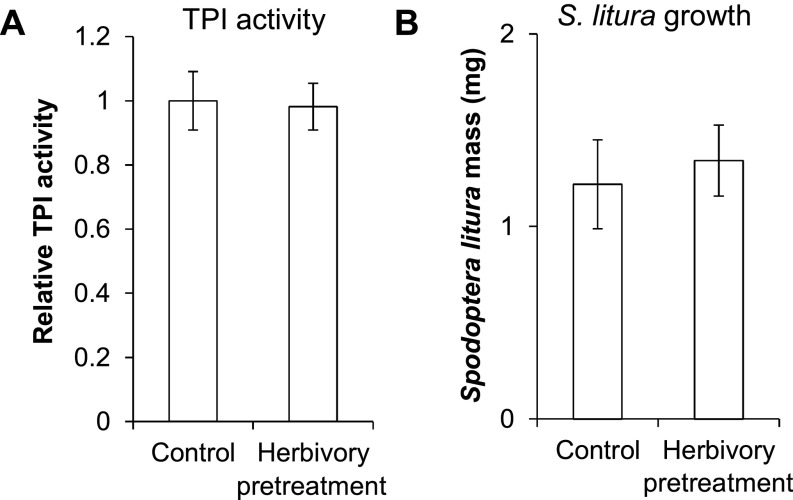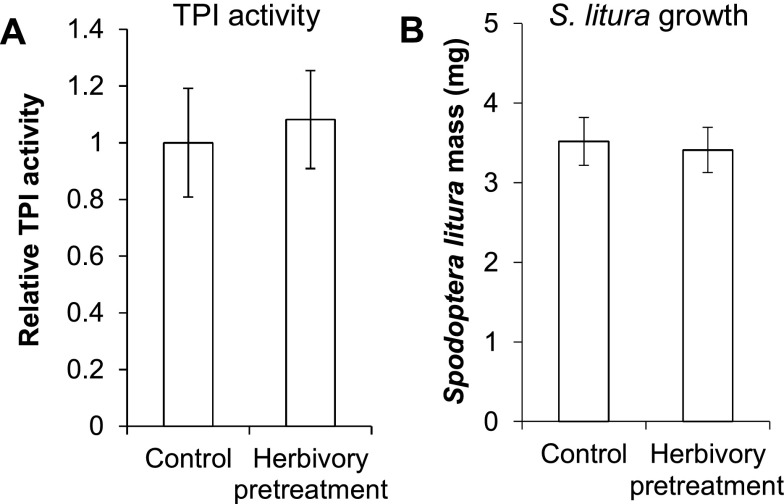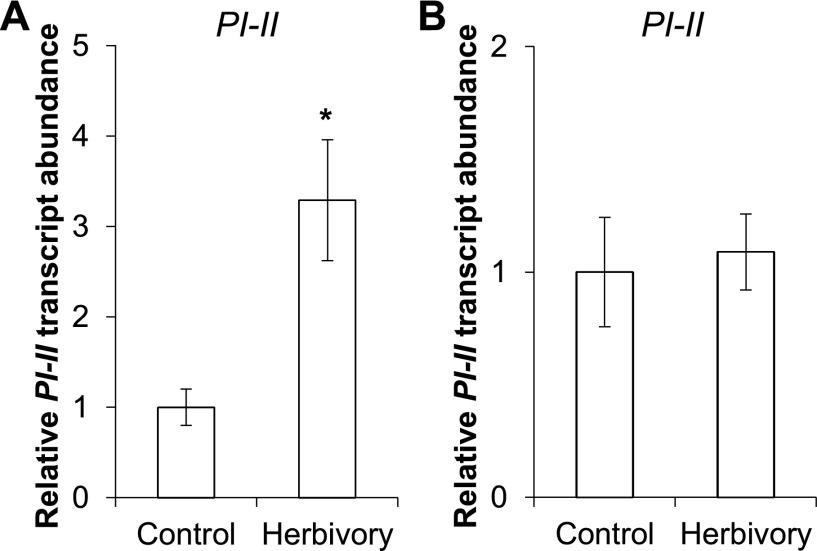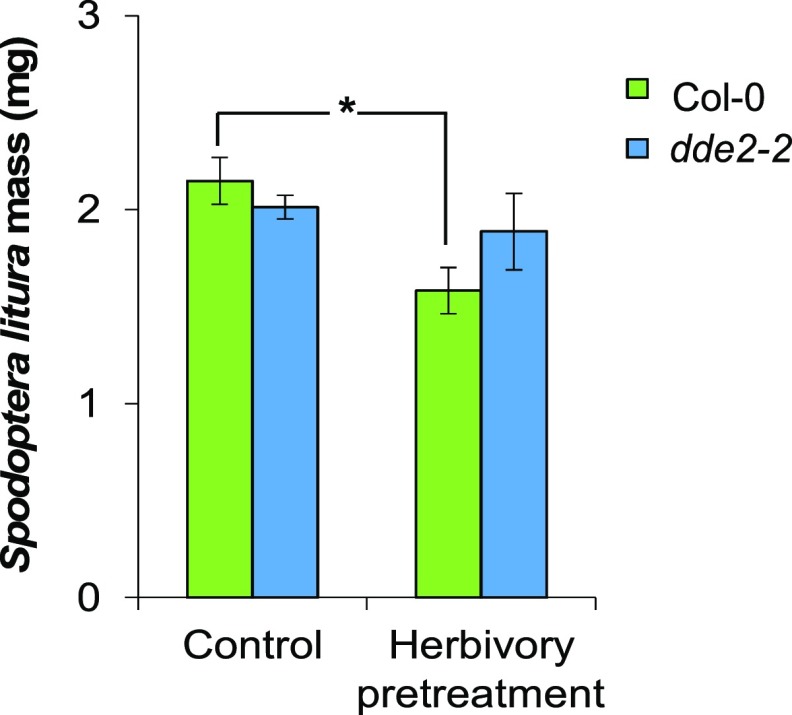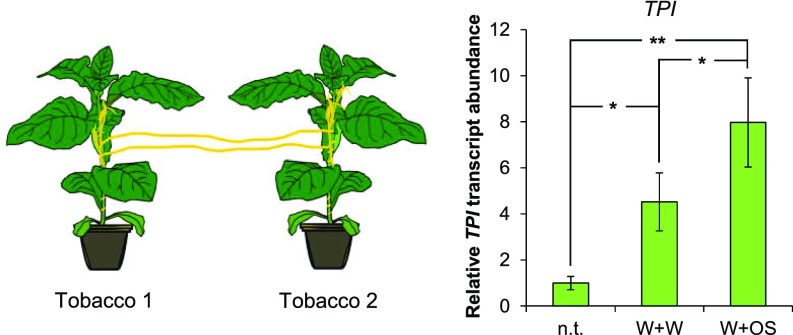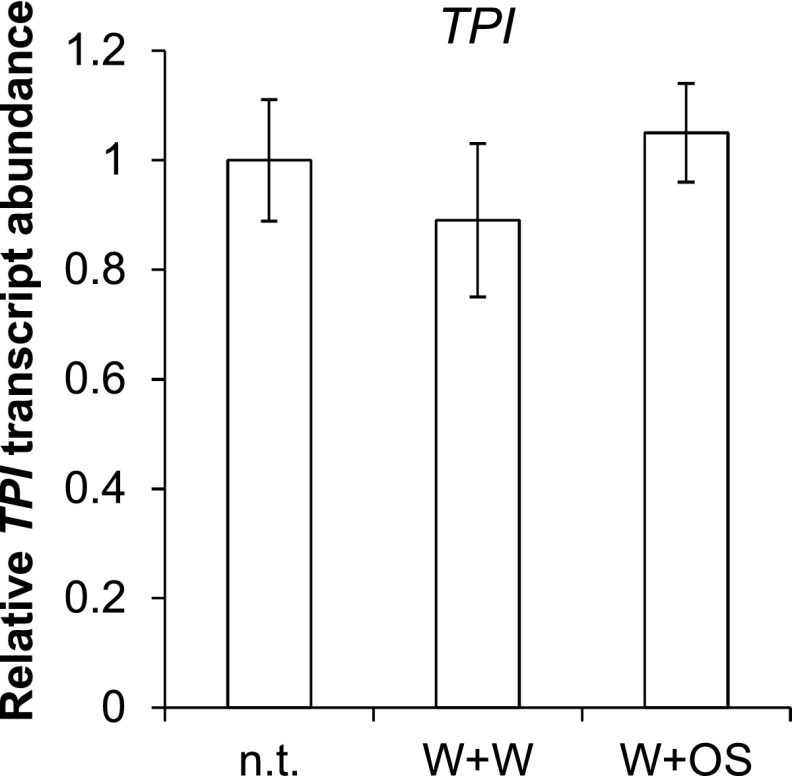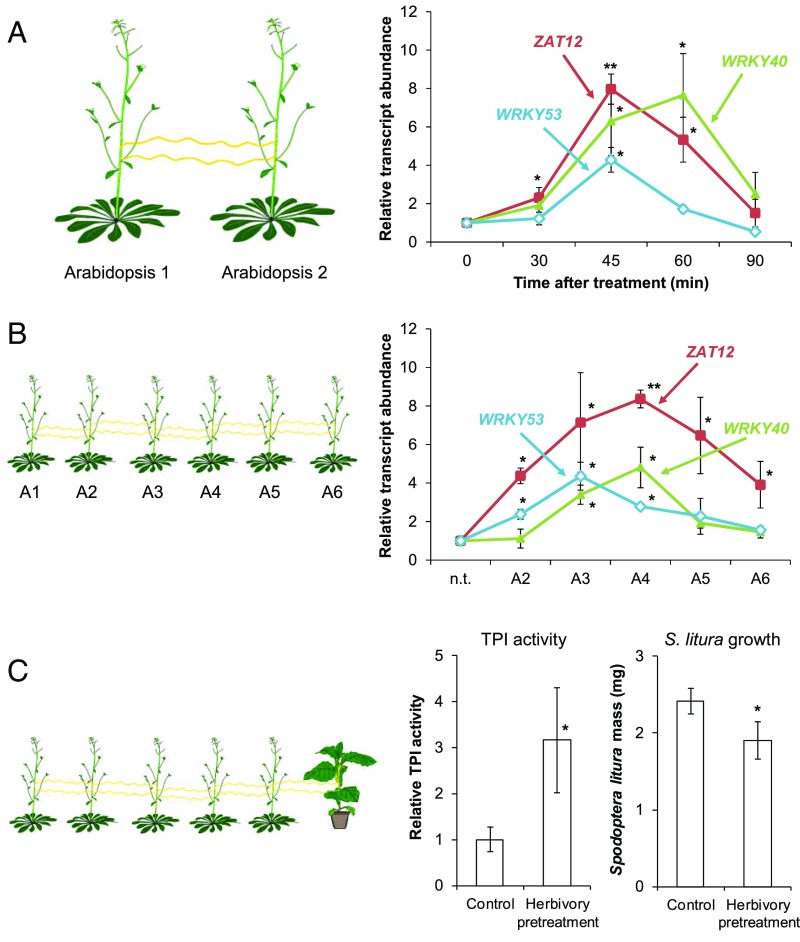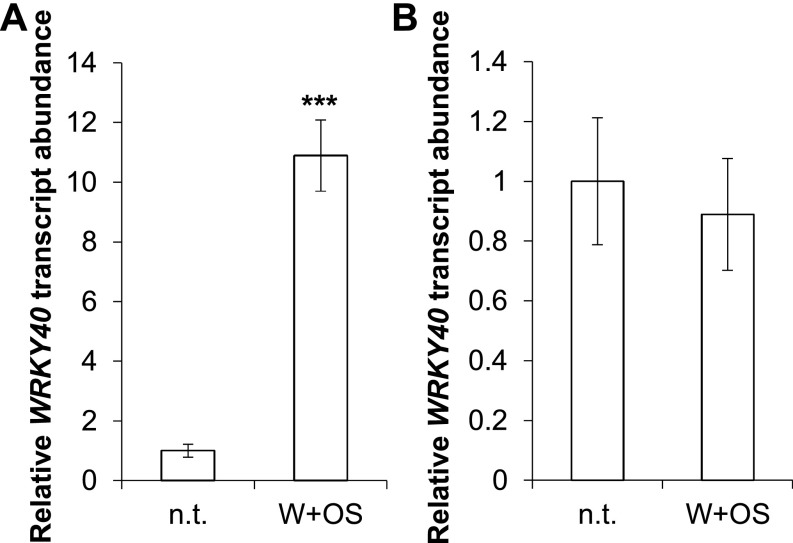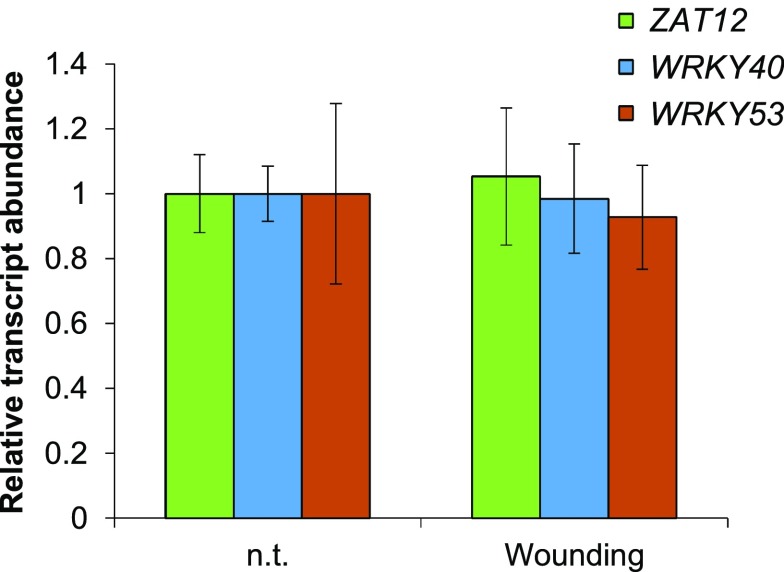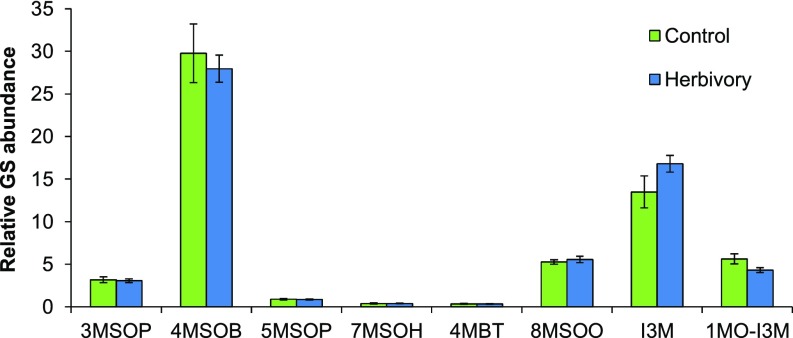Significance
Cuscuta spp. (i.e., dodders) are plant parasites that connect to the vasculature of their host plants to extract water, nutrients, and even macromolecules. Knowledge of ecologically meaningful communications between host plants and Cuscuta, or between Cuscuta bridge-connected hosts, has remained obscure until now. Here we show that herbivore attack on one of the Cuscuta bridge-connected plants induces gene expression and increases the activity of trypsin proteinase inhibitors, and thus elevates the resistance to insects in other undamaged but Cuscuta-connected plants. This Cuscuta-mediated interplant signaling is rapid, conserved, far-reaching, and partly requires the plant hormone jasmonic acid. Although Cuscuta parasites can negatively influence their host plants, under certain circumstances, they may also provide ecologically relevant information-based benefits.
Keywords: Cuscuta, parasitic plant, systemic defense, herbivore, jasmonic acid
Abstract
Cuscuta spp. (i.e., dodders) are stem parasites that naturally graft to their host plants to extract water and nutrients; multiple adjacent hosts are often parasitized by one or more Cuscuta plants simultaneously, forming connected plant clusters. Metabolites, proteins, and mRNAs are known to be transferred from hosts to Cuscuta, and Cuscuta bridges even facilitate host-to-host virus movement. Whether Cuscuta bridges transmit ecologically meaningful signals remains unknown. Here we show that, when host plants are connected by Cuscuta bridges, systemic herbivory signals are transmitted from attacked plants to unattacked plants, as revealed by the large transcriptomic changes in the attacked local leaves, undamaged systemic leaves of the attacked plants, and leaves of unattacked but connected hosts. The interplant signaling is largely dependent on the jasmonic acid pathway of the damaged local plants, and can be found among conspecific or heterospecific hosts of different families. Importantly, herbivore attack of one host plant elevates defensive metabolites in the other systemic Cuscuta bridge-connected hosts, resulting in enhanced resistance against insects even in several consecutively Cuscuta-connected host plants over long distances (> 100 cm). By facilitating plant-to-plant signaling, Cuscuta provides an information-based means of countering the resource-based fitness costs to their hosts.
It has long been recognized that plants react to insect feeding in a highly sophisticated and well-organized manner. When a leaf is attacked, it responds to the wounding, and, in some cases, certain insect-derived elicitors that are introduced into wounds during attack, with a series of rapidly activated signaling events, including MAPK activation, Ca2+ influxes, and jasmonic acid (JA) biosynthesis, which eventually lead to the accumulations of defense metabolites that enhance defense against further attack (1, 2).
As an integrated system, different parts of a plant, such as individual leaves, shoots, and roots, constantly communicate to coordinate growth and development, as well as respond to environmental stresses, including herbivory. Insect herbivory not only activates defenses at the site of feeding, but also induces unknown mobile signals that travel through vasculatures to other parts of the damaged (local) leaf and even to undamaged (systemic) leaves and roots, triggering systemic defense responses (1, 3–5). Systemic defense was first discovered in the tomato (Solanum lycopersicum): after leaf wounding, systemic leaves were found to increase the production of an important defensive metabolite, proteinase inhibitor (PI)-I (6). Since then, much research has revealed that, after wounding or insect feeding, systemic signaling plays an important role in regulating defense-related responses in systemic tissues. However, the nature of the mobile systemic signals is not fully understood. Reciprocal grafting experiments using WT and mutant tomato plants deficient in JA production and perception indicate that induction of PI-II in systemic leaves requires the capability of JA biosynthesis in local leaves and perception in systemic leaves, demonstrating the involvement of JA in wounding-induced systemic signaling (7). Wounding Arabidopsis leaves also increases the contents of JA and JA-isoleucine conjugate in systemic leaves within minutes (8). Moreover, reactive oxygen species (ROS) were found to be produced in local and systemic leaves of Arabidopsis and appeared to play a role in the propagation of systemic signals (9), and several studies have pointed to the involvement of electric signals in wounding- and insect feeding-induced systemic signaling (10–12).
Cuscuta spp. (i.e., dodders) are stem holoparasites with wide host ranges. Cuscuta seedlings are thread-like (without roots and cotyledons), and, after contacting hosts, they form initial haustoria, organs that penetrate into hosts, transporting various substances, including water and nutrients, from hosts to the parasites. Subsequently, seedlings rapidly develop into tendrils, which coil around hosts, continuously forming new haustoria and branching vines. During a vigorous growth stage, Cuscuta vines often extend from the initial hosts and parasitize neighboring plants, forming clusters of plants that are connected by one or more Cuscuta parasites.
Recent studies have shown that certain host metabolites, proteins, and mRNAs can be detected in Cuscuta (13–16), and even viruses can be transferred from one host to another through Cuscuta bridge connections (17). For example, glucosinolates (GSs) in Arabidopsis can be translocated to Cuscuta gronovii and protect this parasite against pea aphids (Acyrthosiphon pisum) (16). Similarly, a hemiparasite, Castilleja indivisa (Scrophulariaceae), also transports alkaloids (mainly lupanine) from lupine (Lupinus texensis), and these hemiparasites exhibited decreased herbivore damage, increased visitation by pollinators, and lifetime seed production (18, 19). However, whether ecologically meaningful signals are communicated among hosts and Cuscuta and even among hosts in Cuscuta-connected plant clusters is unknown. Here we demonstrate that, in these clusters, Cuscuta mediates herbivory-induced interplant signaling that activates defense responses and primes the undamaged host plants in Cuscuta bridge-connected hosts against subsequent insect attack.
Results
Insect Feeding Induces Transcriptomic Reconfigurations in All Members of Cuscuta Bridge-Connected Clusters and Elicits Resistance in Connected but Unattacked Host Plants.
Vasculature conveys systemic signals within plants, and, given that Cuscuta parasites fuse to a host’s vasculature system, we tested whether insect feeding on one host plant could induce defense responses in the other unattacked/systemic but Cuscuta-connected hosts. Soybean (Glycine max) plants were infested with Cuscuta australis vines, and, during the vigorous growth stage, pairs of soybean plants were created by placing two C. australis-infected soybean hosts next to each other and allowing C. australis vines to parasitize and connect the two hosts. When the soybean plant clusters were established, soybean leaves (local leaves; named L leaves) were infested with Spodoptera litura larvae or left untreated (controls). After 24 h of feeding, the L leaves, the systemic leaves of the caterpillar-attacked plants (S1 leaves), the leaves of the connected but undamaged systemic plant (S2 leaves), and the vines of C. australis were harvested for RNA-sequencing (RNA-seq) analysis (Fig. 1A).
Fig. 1.
S. litura feeding induces transcriptional changes and increases defense and resistance levels in leaves of undamaged but Cuscuta-connected soybean plants. (A) Venn diagrams depicting the numbers of differentially regulated genes in L, S1, and S2 leaves (detailed descriptions of these genes are provided in Dataset S1). After 24 h of S. litura feeding on the L leaves, the L leaves, S1 leaves, S2 leaves, and the vines of C. australis that connected both host plants were harvested for RNA-seq analyses (n = 3). (B) The TPI activity and resistance levels of the systemic host plants. L leaves were infested with S. litura for 48 h (herbivory pretreatment) or left untreated (control), and S2 leaves from both groups were then harvested for TPI activity quantification (n = 6; Left), or were infested with S. litura larvae (n = 35), with insect masses determined after another 72 h (Right). Values in the control group are normalized to 1; values are means ± SE, and asterisks indicate significant differences between plants of the control group and herbivory pretreatment group (*P < 0.05, t test).
Compared with the control group, 904 genes were up- or down-regulated at least onefold (820 and 84, respectively) in the L leaves after S. litura infestation, and the S1 leaves had 655 genes with altered transcript levels (519 up- and 136 down-regulated), consistent with the activity of systemic signals moving from the local to systemic leaves within the attacked plants. Importantly, 566 genes (283 up- and 283 down-regulated) were regulated in S2 leaves (Fig. 1A; genes are listed in Dataset S1), suggesting that C. australis bridge connections allowed herbivory-induced systemic signals to reach the connected second hosts. Most genes in the L and S1 leaves were induced (approximately 90% and 80%, respectively), whereas only 50% were induced in the S2 leaves (Dataset S1). The regulated genes had little overlap: (i) 703, 362, and 353 genes responded specifically in L, S1, and S2 leaves; and (ii) only 49 genes were commonly regulated, among which seven showed different directions of expression level changes between L, S1, or S2 leaves (Fig. 1A and Fig. S1). Importantly, two genes, Glyma09g28310 and Glyma16g33710, which encode trypsin protease inhibitors (TPIs; important antiinsect proteins), were up-regulated in all L, S1, and S2 leaves, suggesting that, in response to herbivory, all Cuscuta-connected soybean plants in a cluster may have elevated defense levels.
Fig. S1.
Most, but not all, of the 49 commonly regulated genes in L, S1, or S2 leaves (Fig. 1 and Dataset S1) have similar expression patterns. Pairs of soybean plants were bridge-connected by C. australis, and Spodoptera litura larvae were used to infest soybean leaves (local leaves; L). After 24 h of feeding, the L leaves, S1 leaves, and S2 leaves were harvested for RNA-seq analyses (n = 3). Leaves collected from the same positions in the untreated group served as the controls. The heat map illustrates the relative expression levels (fold change after log2 transformation) of the 49 commonly regulated genes in L, S1, and S2 soybean leaves after 24 h of S. litura herbivory to L leaves. (#Seven genes showed different directions of expression level changes between L, S1, or S2 leaves; the two genes, Glyma09g28310 and Glyma16g33710, that encode trypsin protease inhibitors are highlighted with a red frame.)
To elucidate the biological processes that were involved in the response to S. litura feeding on L leaves, overrepresentation analyses on the differentially expressed genes (DEGs) were performed using MetGenMap (20). In the L leaves, three pathways were strongly (P < 0.001) enriched: “jasmonic acid biosynthesis,” “divinyl ether biosynthesis II,” and “13-LOX and 13-HPL pathway” (Table S1). The DEGs in S1 leaves were strongly enriched in “cellulose biosynthesis,” “jasmonic acid biosynthesis,” and three “asparagine biosynthesis” pathways (Table S1). In the S2 leaves, “glycerol degradation I” and “cellulose biosynthesis” were the most significantly (P < 0.001) enriched pathways (Table S1). It is noteworthy that the “monoterpene biosynthesis” pathway was regulated (P < 0.05) in all leaves, and monoterpenes may function as an indirect defense by attracting the predators of herbivorous insects (21). Furthermore, almost all significantly enriched pathways in S2 leaves could be found in S1 leaves, except “glycerol degradation I,” suggesting that S1 and S2 leaves had similar defense-related responses.
Table S1.
Overrepresentation analyses using MetGenMap on the differentially expressed pathways in the S. litura attacked soybean–C. australis–soybean plant cluster
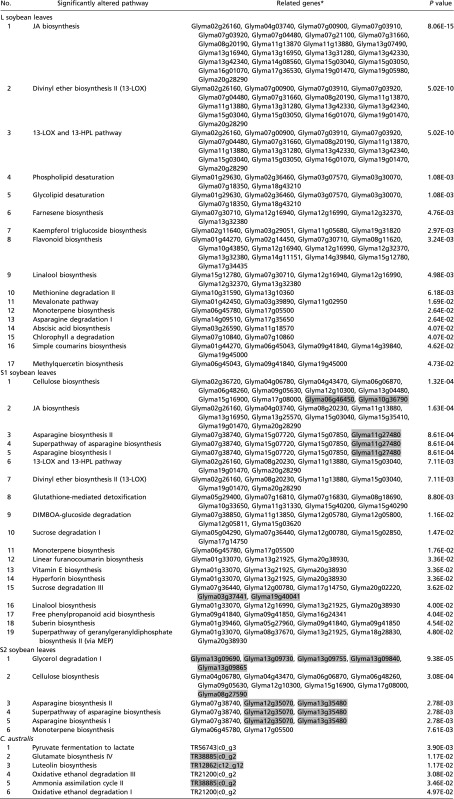 |
Genes whose accession numbers are highlighted with grey are down-regulated; otherwise, genes are up-regulated.
The RNA-seq analysis of C. australis vines revealed 140 DEGs (79 and 61 up- and down-regulated, respectively) after S. litura feeding on L leaves (Dataset S2), including genes encoding proteins with leucine-rich repeats, cytochrome P450s, Ca2+-binding proteins, and proteins from the superfamily of protein kinases. The most significantly altered pathways were all related to primary metabolism (Table S1).
These data indicate that Cuscuta bridge connections between different hosts enable a new type of interplant systemic signaling, inducing transcriptome rearrangements in the systemic undamaged hosts. To examine if these large transcriptomic changes in the systemic plants are associated with enhanced herbivore resistance, soybean–C. australis–soybean plant clusters were established, L leaves were treated with S. litura feeding or left untreated (pretreated group and control group, respectively), and the S2 leaves of the systemic soybean plants were examined for the activity of defense metabolite TPI and insect resistance. After 48 h of S. litura feeding on L leaves, the TPI activity in the S2 leaves was ∼40% greater than in the control group (Fig. 1B), and these S2 leaves with enhanced defense consistently exhibited elevated resistance to insects, as indicated by the fact that, 3 d after infesting S2 leaves, the masses of S. litura neonates were ∼16% lower than those on the S2 leaves of the control group (Fig. 1B). Given that hundreds of DEGs were detected in S2 leaves, it is likely that other induced defenses, in addition to TPIs, also contributed to the elevated resistance to S. litura.
Plants release volatile organic compounds in response to wounding and herbivore attack, some of which may elicit resistance-related reactions in neighboring plants (21). To rule out the possibility that airborne signals from the L leaves induced the aforementioned responses in the S2 leaves, pairs of C. australis-infected soybean plants were created, but, this time, C. australis parasites were not allowed to bridge connect the host pairs, and, in each soybean plant pair, one was left untreated or fed on by S. litura for 24 h. RNA-seq revealed that there were only 26 DEGs in the S2 leaves (Dataset S3), and one of these, a nakin-2-like gene (Glyma04g35030), was significantly changed regardless of whether there were Cuscuta bridges, but in opposite directions (Datasets S1 and S3). Consistently, when soybean pairs were not connected by C. australis, neither TPI activity nor increased resistance could be detected in the untreated host plants (Fig. S2). Moreover, when we examined whether there are airborne signals between two soybean plants, which were not parasitized at all (Dataset S4), only 35 DEGs were found, and none of these genes were in common with the DEGs in the other two setups (Datasets S1 and S3).
Fig. S2.
Without Cuscuta connections, S. litura herbivory on soybean does not increase trypsin protease inhibitor activity and herbivore defense in the S2 leaves of undamaged neighboring soybean plants. C. australis-parasitized soybean plants were arranged pairwise, but without forming bridge connections between them. The L leaves were treated with S. litura feeding for 48 h (herbivory pretreatment) or left nontreated (control). S2 leaves (n = 6) were harvested for TPI activity quantification (A) or were infested with S. litura larvae (n = 27), and insect masses were determined after 72 h (B). Values are means ± SE, and the values from the control groups are normalized to 1. No statistical significance was found (t test).
The DEGs identified in these experiments likely resulted from random errors (22), and parasitization did not appear to oversensitize soybean to the airborne signals. Thus, a role for airborne signals in mediating the between-plant signaling could be ruled out.
Cuscuta-Mediated Interplant Signaling Is Well Conserved and Involves JA Pathway.
As the host plants in the Cuscuta-connected plant clusters can be different species, we evaluated whether insect feeding increases the defense levels of systemic plants in a heterospecific hosts system. Plant clusters, each of which consisted of an Arabidopsis (Brassicaceae)–C. australis–tobacco (Solanaceae) combination (Fig. 2A), were established. Arabidopsis plants were treated with S. litura feeding for 48 h (pretreated group) or untreated (control group). Compared with those in the control group, the TPI activity levels in the systemic tobacco plants of the pretreated group increased eightfold (Fig. 2B). The tobacco plants in both groups were infested with S. litura for another 72 h to evaluate their resistance levels, and it was found that, compared with those in the control group, the average mass of S. litura in the pretreated group was 32% smaller (Fig. 2C). Without C. australis bridge connections, after 48 h of S. litura feeding on Arabidopsis, the neighboring tobacco plants showed no signs of elevated TPI activity and, consistently, these tobacco plants did not exhibit increased resistance to S. litura (Fig. S3). Similarly, in soybean (Fabaceae)–C. australis–wild tomato (Solanum pennellii; Solanaceae) plant clusters, 8 h after soybean leaves were treated with S. litura feeding, the transcript levels of PI-II (encoding defensive PIs) in the wild tomato were elevated more than twofold (Fig. S4A). Again, treatment of soybean did not affect PI-II transcript abundance in unconnected wild tomato plants, allowing airborne signals to be ruled out (Fig. S4B).
Fig. 2.
Cuscuta-mediated interplant signaling occurs between heterospecific hosts and involves the JA pathway. (A) Schematic of an Arabidopsis–C. australis–tobacco plant cluster. Arabidopsis leaves were infested with S. litura for 48 h (herbivory pretreatment) or untreated (control). Tobacco leaves were harvested for determination of relative TPI activity (n = 6; values in the control group are normalized to 1) (B), or infested with S. litura (n = 25) and, after 72 h of feeding, the masses of these insects were determined (C). Values are means ± SE, and asterisks indicate significant differences between controls and the herbivory pretreatment group (*P < 0.05 and **P < 0.01, t test). (D) Venn diagram depicting the specifically and commonly regulated genes in tobacco plants connected with Arabidopsis WT (Col-0) or the JA-deficient dde2-2 plants. Col-0 and dde2-2 were untreated or wounded with a pair of forceps, and tobacco samples were harvested after 8 h to analyze the transcriptional responses by RNA-seq (details are provided in Dataset S5).
Fig. S3.
Without Cuscuta bridge connections, insect herbivory on Arabidopsis does not induce detectable defense responses in undamaged neighboring tobacco plants. C. australis-parasitized Arabidopsis and tobacco plants were arranged pairwise but without forming C. australis bridge connections between them. Arabidopsis hosts were treated with 48 h of S. litura feeding (herbivory pretreatment) or untreated (control). The paired tobacco plants were harvested for determination of TPI activity (n = 6) (A) or were infested with S. litura (n = 25) with masses of these insects determined after another 72 h (B). Values are means ± SE, and the values of the control groups are normalized to 1. No statistical significance was found (t test).
Fig. S4.
Cuscuta conveys insect herbivory-induced systemic signals from soybean to wild tomato. (A) Transcript levels of PI-II in the wild tomato plants. In soybean (Glycine max)–C. australis–wild tomato (S. pennellii) plant clusters, soybean plants were treated with S. litura feeding for 8 h (herbivory) or left untreated (control), and the PI-II transcript levels were determined in the connected wild tomato plants. (B) Transcript levels of PI-II in the wild tomato plants when they were not bridge-connected with soybean by C. australis. C. australis-parasitized soybean and wild tomato plants were arranged pairwise without forming bridge connections. Soybean hosts were treated with 8 h of S. litura feeding (herbivory) or untreated (control), and the paired wild tomato plants were harvested for determination of PI-II expression. Values are means ± SE, and the values of the control groups are normalized to 1. No statistical significance was found (n = 5; *P < 0.05, t test).
Several studies have indicated the involvement of JA in systemic defense responses (7, 8, 23). To investigate the role of JA in Cuscuta-mediated systemic signaling between plants, WT (Col-0) and dde2-2 Arabidopsis (24), which harbors a mutation in the JA biosynthesis gene AOS (allene oxide synthase), were connected pairwise to tobacco plants. Arabidopsis plants were untreated or wounded, and, after 8 h, the leaves of the tobacco were harvested for RNA-seq analysis (Fig. 2D). Wounding was chosen instead of insect feeding because dde2-2 mutant is completely impaired in JA biosynthesis; therefore, insects likely cause much greater amounts of damage to dde2-2 plants than WT plants, thereby complicating the analysis.
Compared with the untreated control group, 1,342 DEGs (981 and 361 up- and down-regulated, respectively) were identified in the tobacco of the wound-treatment group (Fig. 2D and Dataset S5), and the most strongly enriched pathways included “13-LOX and 13-HPL” and “jasmonic acid biosynthesis” (Table S2). In contrast, wounding dde2-2 resulted in only 404 DEGs (191 up- and 213 down-regulated) in the tobacco (Fig. 2D and Dataset S5), and “nitrate reduction II (assimilatory),” “ammonia assimilation cycle II,” and “glutamine biosynthesis I” were among the enriched pathways (Table S2). Notably, three genes coding trypsin protease inhibitors, SS15144g00001, SS72472g00002, and SS2003g01003, were up-regulated (18, 2, and infinite times, respectively; the expression level of SS2003g01003 was not detectable in controls but relatively high after induction, resulting in an infinite ratio) in the tobacco connected with Col-0, whereas only SS15144g00001 was induced threefold when the tobacco plants were connected with dde2-2 (Dataset S5). Moreover, Venn-diagram analyses indicated that 240 tobacco genes were commonly regulated in the tobacco plants in both Col-0–Cuscuta–tobacco and dde2-2–Cuscuta–tobacco plant clusters (Fig. 2D). Among these, 115 genes showed very similar patterns of regulation (the differences between the levels of wound-induced changes in these two plant clusters were not more than 50%; Dataset S5). Likely, transcriptional regulation of these 115 genes does not require the JA pathway in the local plants, whereas the expression of the other 125 genes is probably partly dependent on JA. Furthermore, 164 genes were uniquely regulated in the tobacco of the dde2-2–Cuscuta–tobacco plant clusters (Fig. 2D), and we speculate that these genes were regulated by systemic signal(s) that is/are normally suppressed by the JA pathway. In line with these RNA-seq data, S. litura feeding on the dde2-2 mutants could no longer prime the connected tobacco plants against subsequent insect attack (Fig. S5).
Table S2.
Overrepresentation analyses using MetGenMap on the differentially expressed pathways in the Arabidopsis–C. australis–tobacco plant cluster
| No. | Significantly altered pathway | P value |
| Tobacco leaves (Col-0-tobacco cluster) | ||
| 1 | 13-LOX and 13-HPL pathway | 1.94E-05 |
| 2 | JA biosynthesis | 1.16E-03 |
| 3 | Oxygenic photosynthesis | 1.89E-03 |
| 4 | Photosynthesis light reactions | 2.24E-03 |
| 5 | Proline degradation II | 4.11E-03 |
| 6 | Phenylpropanoid biosynthesis | 7.22E-03 |
| 7 | Luteolin biosynthesis | 1.18E-02 |
| 8 | Ammonia assimilation cycle II | 1.64E-02 |
| 9 | Thioredoxin pathway | 2.26E-02 |
| 10 | Free phenylpropanoid acid biosynthesis | 2.26E-02 |
| 11 | Pyrimidine deoxyribonucleotides de novo biosynthesis | 4.63E-02 |
| 12 | GS biosynthesis from tryptophan | 4.63E-02 |
| 13 | Superpathway of aspartate and asparagine biosynthesis | 4.63E-02 |
| Tobacco leaves (dde2-2-tobacco cluster) | ||
| 1 | Nitrate reduction II (assimilatory) | 5.32E-04 |
| 2 | Ammonia assimilation cycle II | 5.32E-04 |
| 3 | Glutamine biosynthesis I | 5.29E-03 |
| 4 | 13-LOX and 13-HPL pathway | 7.32E-03 |
| 5 | β-Caryophyllene biosynthesis | 1.95E-02 |
| 6 | Glycolipid desaturation | 2.91E-02 |
| 7 | Suberin biosynthesis | 3.74E-02 |
| 8 | Allantoin degradation to glyoxylate II | 3.86E-02 |
| 9 | Ammonium transport | 3.86E-02 |
| 10 | Allantoin degradation to ureidoglycolate II (ammonia producing) | 3.86E-02 |
| 11 | 4-Aminobutyrate degradation I | 3.86E-02 |
| 12 | Glycolate and glyoxylate degradation II | 3.86E-02 |
| 13 | Proline degradation II | 3.86E-02 |
| Tobacco leaves (Col-0-tobacco cluster) | ||
| 1 | Glutamine biosynthesis I | 2.08E-03 |
| 2 | Ammonia assimilation cycle II | 4.87E-03 |
| 3 | Nitrate reduction II (assimilatory) | 4.87E-03 |
| 4 | Glycolipid desaturation | 1.19E-02 |
| 5 | β-Caryophyllene biosynthesis | 1.22E-03 |
| 6 | Proline degradation II | 2.42E-03 |
| 7 | Ammonium transport | 2.42E-02 |
| 8 | 4-Aminobutyrate degradation I | 2.42E-02 |
| 9 | Glycolate and glyoxylate degradation II | 2.42E-02 |
| 10 | Asparagine biosynthesis I | 3.61E-02 |
| 11 | Trans-cinnamoyl-CoA biosynthesis | 4.79E-02 |
| 12 | Thioredoxin pathway | 4.79E-02 |
Fig. S5.
S. litura feeding on Arabidopsis increases the resistance levels of undamaged but Cuscuta-connected tobacco plants in a jasmonic acid (JA)-dependent manner. Arabidopsis (Col-0 or dde2-2)-C. australis-tobacco plant clusters were established, and Arabidopsis leaves were infested with S. litura (herbivory pretreatment) or untreated (control). After 48 h, tobacco leaves were infested with S. litura (n = 30) and following 72 h of feeding, the masses of these insects were determined. Values are means ± SE and asterisks indicate significant differences between controls and the herbivory pretreatment group (*P < 0.05. t test).
Based on these results, we concluded that Cuscuta bridge connections transmit conserved insect herbivory-induced systemic signals among different conspecific or heterospecific hosts, and, importantly, this interplant signaling plays an important role in priming all connected hosts in clusters against insect attack. Furthermore, the JA pathway in the local wounded plants is crucial in initiating and/or maintaining the systemic signals, and it is possible that there is more than one mobile signal that could travel through Cuscuta bridges between plants.
Insect-Derived Elicitors Amplify Wound-Induced Defenses in Cuscuta-Connected Systemic Plants.
Many solanaceous plants, such as tobacco (Nicotiana tabacum), are able to perceive insect oral secretions (OS) and activate stronger defense responses than after mechanical wounding does alone in local and systemic tissues (1). To evaluate whether the perception of insect-derived elicitors induces higher levels of defenses in Cuscuta bridge-connected systemic plants than wounding does alone, three different groups of C. australis-connected tobacco pairs (named Tobacco 1 and 2) were established: control untreated (n.t.) and pairs in which Tobacco 1 was wounded and treated with water (W+W) or treated with S. litura OS (W+OS; Fig. 3). The leaves of the systemic Tobacco 2 plants were harvested after 8 h; TPI transcript levels increased in the W+W-treated group, and these levels were amplified in the W+OS-treated group (Fig. 3). Again, no evidence of airborne signals was found in tobacco pairs arranged similarly, but without C. australis bridge connections (Fig. S6).
Fig. 3.
Insect OS amplify wounding-induced levels of TPI in Cuscuta bridge-connected systemic tobacco plants. (Left) Schematic of paired C. australis-connected tobacco plants. Tobacco 1 was not treated (n.t.) or wounded with a pattern wheel, and 40 µL of water (W+W) or S. litura OS (W+OS) were immediately applied to the wounds; samples from Tobacco 2 were harvested after 8 h and the TPI transcript levels were determined (Right). The nontreated (n.t.) group served as controls, and their values are normalized to 1. Values are means ± SE, and asterisks indicate significant differences (n = 5; *P < 0.05 and **P < 0.01, t test).
Fig. S6.
Without Cuscuta bridge connections, wounding or simulated insect herbivory on tobacco does not induce detectable defense responses in the undamaged neighboring tobacco plants. Tobacco plants were arranged pairwise and infested with C. australis but without forming bridge connections between them. One host was treated with W+W or W+OS or left nontreated (n.t.), and, at 8 h, the paired tobacco plants were analyzed for TPI transcript accumulation (n = 5). Values in the n.t. group are normalized to 1. Values are means ± SE; no statistical significance was found (t test).
From these results, we infer that the interplant systemic signals can be amplified after perception of the elicitors in insect OS and pass through Cuscuta to activate herbivory-specific defense responses in systemic host plants.
C. australis-Mediated Interplant Signaling Is Rapid and Can Be Transmitted over Long Distances.
The early systemic responses to wounding have been well studied in Arabidopsis plants, and several systemic marker genes that rapidly respond to wounding/herbivory are known (9). To determine how rapidly this form of interplant signaling can occur between C. australis bridge-connected hosts, two Arabidopsis plants (Arabidopsis 1 and 2) were infested with C. australis to form Arabidopsis–C. australis–Arabidopsis plant clusters (Fig. 4A). Arabidopsis 1 was wounded to mimic insect feeding (insect feeding behavior is difficult to control; thus, simulated herbivory was used to precisely synchronize the elicitations). Transcriptional responses in Arabidopsis 2 were detected as early as 30 min after the wounding of Arabidopsis 1, when the transcript abundances of three wound-inducible systemic marker genes (9), ZAT12, WRKY40, and WRKY53, increased several fold in the leaves of Arabidopsis 2 (Fig. 4A). Similarly, W+OS treatment of tobacco in heterospecific tobacco–C. australis–Arabidopsis plant clusters increased the transcript levels of WRKY40 in the neighboring Arabidopsis approximately 10-fold at 45 min (Fig. S7). Thus, the systemic signal travels in a relatively high speed, approximately 1 cm/min, inferred from the distances between the hosts.
Fig. 4.
C. australis mediates rapid and far-reaching wounding- and herbivory-induced systemic signaling. (A) Wounding-induced responses in the systemic undamaged Arabidopsis in C. australis-connected Arabidopsis plant pairs. (Left) Schematic of C. australis-connected Arabidopsis pairs. Arabidopsis 1 was wounded with a pair of forceps, and the transcriptional responses of marker genes at the indicated times in Arabidopsis 2 were determined (Right). (B) Wounding-induced systemic responses in multiple Arabidopsis plants consecutively connected by C. australis. Schematic of six Arabidopsis plants (A1–A6) in a row pairwise connected by five C. australis plants (Left). The first plant (A1) was wounded or not treated (n.t.), and the relative transcript levels of ZAT12, WRKY40, and WRKY53 in the A2–A6 plants were quantified 90 min after wounding (Right). Values from the group not treated are normalized to 1 (n = 5). (C) Herbivory-induced systemic responses in tobacco sequentially connected to five Arabidopsis plants. The first Arabidopsis plant was infested with S. litura for 48 h (herbivory pretreatment) or not treated (control). Tobacco leaves were harvested for determination of TPI activity (n = 6) or infested with S. litura (n = 25) and, after 72 h of feeding, the masses of these insects were determined. Values are average ± SE, and asterisks indicate significant differences between plants of the control group and the pretreatment group (*P < 0.05 and **P < 0.01, t test).
Fig. S7.
C. australis mediates rapid systemic signals between heterospecific tobacco and Arabidopsis host plants. (A) Tobacco (N. tabacum)–C. australis–Arabidopsis (A. thaliana) plants were arranged in a manner similar to that in Fig. 2, and tobacco plants were treated with W+OS or left untreated (n.t.). The paired Arabidopsis plants were harvested 45 min after W+OS treatment on tobacco for determination of the relative transcript abundance of WRKY40. (B) Cuscuta-infested tobacco and Arabidopsis plants without parasite connections between them were arranged pairwise. Tobacco plants were treated with W+OS or left untreated (n.t.), and WRKY40 expression was quantified in Arabidopsis harvested 45 min after the treatment on tobacco. Values from the n.t. group are normalized to 1. Values are average ± SE, and asterisks indicate significant differences between the non-treated and treated groups (n = 5; ***P < 0.001, t test).
In nature, one or multiple Cuscuta plants can simultaneously parasitize multiple hosts in neighborhoods, forming interconnected plant clusters (25). To determine whether Cuscuta-mediated interplant signaling can occur over multiple plants connected by different Cuscuta parasites, six Arabidopsis plants (A1–A6; ∼100-cm total distance) were pairwise connected in a row by five individual C. australis (Fig. 4B). After the first plant (A1) was wounded, the transcript levels of ZAT12, WRKY40, and WRKY53 in A2–A6 were determined. At 90 min, these genes’ transcript levels in the A4 plants (Fig. 4B) were similar to those in Arabidopsis 2 plants of the connected pairs of plants at the 45-min time point (Fig. 4A), and the transcript levels in A2 were already decreasing at 90 min, suggesting that the response was propagated as a wave through the connected plants. As A6 started to show detectable responses, we conclude that the Cuscuta-mediated interplant signaling can occur along multiple hosts reaching at least ∼100 cm. We did not find any evidence that airborne signals could induce gene expression in Arabidopsis: without Cuscuta bridge connections, wounding an Arabidopsis did not influence transcript levels of these marker genes in adjacent Arabidopsis plants (Fig. S8).
Fig. S8.
Without Cuscuta bridge connections, wounding Arabidopsis does not induce expression of marker genes in the undamaged neighboring Arabidopsis plants. Arabidopsis plants were arranged pairwise and infested with C. australis but without forming bridge connections between them. In each pair, Arabidopsis 1 plant was left untreated (n.t.) or wounded by a pair of forceps, and, at 45 min, samples of Arabidopsis 2 were collected. The transcript levels of marker genes in Arabidopsis 2 were quantified (n = 6). Values are means ± SE, and the values from the control (n.t.) groups are normalized to 1. No statistical significance was found (t test).
We next examined whether the interplant signaling can activate defenses in the distal plants. As establishing Cuscuta bridge connections between plants is a lengthy process, Arabidopsis plants had started to flower by the time they were well connected by Cuscuta, and, at this stage, the levels of systemic GSs were no longer inducible by S. litura feeding (Fig. S9). Therefore, we replaced the A6 Arabidopsis with a tobacco plant, the TPI activity of which can still be induced after establishment of plant clusters. The Arabidopsis A1 was infested with S. litura, and, after 48 h, tobacco leaves were harvested for determination of TPI activity or infested with S. litura for another 72 h. The TPI activity in these tobacco plants was more than twofold greater than in the nontreated control group (Fig. 4C), and these plants consistently exhibited elevated resistance, as the masses of S. litura neonates were 20% lower than those infested on the controls, which were not pretreated with 48 h of S. litura feeding on A1 (Fig. 4C).
Fig. S9.
Glucosinolate (GS) levels in Arabidopsis systemic leaves do not change after S. litura feeding. Arabidopsis plants infested with C. australis were left untreated (control) or subjected to S. litura herbivory. After 48 h of feeding, systemic leaves were harvested and GS levels were quantified. Values are means ± SE (n = 6). (I3M, indol-3-ylmethyl-; 1MOI3M, 1-methoxyindol- 3-ylmethyl-; 3MSOP, 3-methylsulfinylpropyl-; 4MSOB, 4-methylsulfinylbutyl-; 5MSOP, 5-methylsulfinylpentyl-; 7MSOH, 7-methylsulfinylheptyl-; 4MTB, 4-methylthiobutyl-; 8MSOO, 8-methylsulfinyloctyl-).
Thus, the Cuscuta-mediated interplant systemic signaling occurs rapidly and can induce defense responses even in distantly connected hosts.
Discussion
Cuscuta parasitism influences host physiology and affects host–insect interactions, as Cuscuta draws water and nutrients from hosts and its parasitization likely influences host JA and/or salicylic acid levels, leading to changes in defense against insects; for example, Cuscuta-parasitized tomato exhibited increased resistance to the beet armyworm Spodoptera exigua (26, 27). In the present study, by using Cuscuta to transmit systemic signals, we studied how insect herbivory on one host plant affects the defenses of the other hosts in the same Cuscuta-connected plant cluster: Cuscuta bridges mediate rapid and far-reaching signaling between con- or heterospecific host plants after wounding/insect herbivory, eliciting changes in the transcriptome and PI activity, and, importantly, systemic signaling primes the undamaged Cuscuta-connected plants against subsequent insect attack in a largely JA-dependent manner.
S. litura feeding on soybean leaves in soybean–C. australis–soybean plant clusters specifically regulated 703, 362, and 353 genes in the L, S1, and S2 leaves, respectively, and these leaves had only a relatively small number of the differentially regulated genes in common (Fig. 1). Variations in systemic responses were also observed in Arabidopsis plants expressing a Ca2+ reporter, aequorin, whereby wounding or Spodoptera littoralis feeding induced different strengths of Ca2+ signals in different leaves (28). In N. attenuata, simulated Manduca sexta feeding elicited distinct levels of phytohormones, activity of MAPKs, and TPI in different systemic leaves (23). A metabolomics analysis indicated that largely different metabolites accumulated in local and systemic rice leaves after Spodoptera frugiperda feeding (29). We infer that the underlying mechanism of the differences in systemic responses in a plant or in a Cuscuta-connected plant cluster is related to the developmental stages of individual parts, the arrangement of vasculature (i.e., phyllotaxis), and the strength of the systemic signals at a given location, as other researchers have discovered in studying within-plant systemic responses (30, 31).
After wounding, the levels of PI-I increased approximately 1- to 10-fold in systemic tomato leaves (6) and simulated Manduca sexta feeding on Nicotiana attenuata resulted in 1- to 3-fold increase of TPI activity in systemic leaves (23). These intraplant systemic responses of PIs are similar to what we observed in the Cuscuta-connected systemic tobacco plants (Figs. 2B and 4C). In soybeans, we also detected similarly enhanced TPI levels in the S1 and S2 leaves (Fig. S1 and Dataset S1). These findings suggest that the levels of Cuscuta-mediated interplant systemic defenses are likely to be similar to those of the defenses induced in intraplant systemic leaves. The effect sizes, quantified in terms of the relatively decreased masses of the insects growing on Cuscuta-bridged systemic plants, were 16% (two Cuscuta-connected soybean plants; Fig. 1B), 32% (Cuscuta-connected Arabidopsis and tobacco; Fig. 2C), 20% (five Cuscuta-connected Arabidopsis and one tobacco plant; Fig. 4C), and 27% (Cuscuta-connected Arabidopsis and tobacco; Fig. S5). In some plant communities, herbivore-induced plant volatiles (HIPVs) induce defense responses in the neighboring plants (21). A meta-analysis indicated the effect size to be approximately 0.5, as estimated from 48 studies on HIPV-induced plant resistance, although most studies measured only plant damages as a response to volatile cues (32). Underground common mycelial networks (CMNs) can also act as conduits for signaling between plants: when connected by a CMN, S. litura feeding on a tomato plant increased the expression of defense-related genes in the other tomato, and approximately 20% decreased insect masses were detected in the systemic tomato (33). Thus, Cuscuta-, HIPV-, and CMN-mediated interplant systemic signaling are all involved in shaping the interactions between plants and insects in different communities, and more research is needed to further demonstrate the ecological role of Cuscuta-mediated interplant signaling in nature.
After wounding or insect herbivory, Cuscuta transfers certain mobile signals between con- and heterospecific hosts, including hosts from different families. The mobile signals are very likely to be the long-sought wounding/herbivory-induced systemic signals, and, concluding from our data, they are well conserved. We propose that herbivory rapidly elicits these conserved mobile signals in the local leaves, from where they travel through the plant vasculature and induce defense-related responses in other parts of the attacked plant; while moving through Cuscuta vines, they activate responses in Cuscuta and reach other hosts to induce their defenses. Notably, the systemic signaling regulates only a small number of genes in Cuscuta, most of which are related to the primary metabolism, suggesting that the parasites are likely only a physical conduit; nevertheless, it cannot be ruled out that the induced defense responses in the receiver host plants are influenced by interactions of the translocated signal molecules with the parasites (e.g., the translocated signaling molecules may activate certain pathways in the parasites that synthesize more of the same or some other signals).
The nature of the mobile signals and their means of propagation remain largely unknown. Studies on tomato, wild tobacco N. attenuata, and Arabidopsis have indicated the involvement of JA in systemic signaling (7, 8, 23). However, several lines of evidence support the involvement of other signals: (i) systemic responses, such as activation of MAPKs, were detected in N. attenuata, even though the local leaves were excised just 10 min after they were treated with simulated insect herbivory, when JA levels hardly increased in the treated leaves (23), and, similarly, Arabidopsis activates JA accumulation in systemic leaves just 2 min after wounding (8, 34); and (ii) electric, hydraulic signals, and ROS are also important parts of systemic signaling (7–9, 11, 12). Importantly, here we show that, compared with the WT Arabidopsis plants, wounding dde2-2 resulted in substantially fewer transcriptional changes in Cuscuta-connected tobacco (Fig. 2D), suggesting that JA itself or certain signaling elements regulated by JA are major components of the systemic signals. The findings from this naturally occurring host–parasite–host grafting system are consistent with the results from an elegant artificial grafting experiment: induction of PI-II in tomato systemic leaves requires the JA biosynthesis pathway in wounded local leaves (7). Furthermore, analysis of the RNA-seq data revealed more than 400 DEGs in the dde2-2–connected tobacco plants, 115 of which are likely not dependent on the JA pathway in the signal sender plants. Thus, other signals are also involved in the Cuscuta-mediated systemic signaling, and this is consistent with the fact that the induction of systemic PI activity in N. attenuata and tomato is independent of JA accumulation in systemic leaves (7, 23).
Plant vasculatures also transmit other types of long-distance signals induced by biotic stresses, such as attack from pathogens (35) and abiotic stresses, including soil water and nutrient deficiencies (36–38). It is likely that Cuscuta could also facilitate multiple stress-induced signaling among different hosts, reshaping the ecology of Cuscuta-infected plant communities. By using mutants and WT plants as hosts, this natural grafting system also provides an opportunity to study the role of different signals and signaling pathways elicited by biotic and abiotic stresses.
Studies on human parasites have indicated that, although parasitism generally weakens the human hosts, in some cases, parasitism can provide certain benefits. For example, women infected with roundworms generally have earlier first births and shortened interbirth intervals, increasing fertility (39), and helminth infections often decrease autoimmunity and allergy in humans (40). Plant parasites decrease the fitness of hosts by exploiting host resources, such as water and nutrients. In plant clusters, Cuscuta bridge connections enable information exchange among hosts, and, in this way, Cuscuta parasitism could alleviate resource-based fitness costs by providing information-based benefits to their hosts. Cuscuta may also benefit from this relationship, given that better defended and prepared hosts could provide Cuscuta with more nutrients than undefended or naïve hosts in the face of a rapidly dispersing herbivore. As Cuscuta spp. are generalists and did not specifically coevolve with any host plant taxa, these are unlikely to be coevolved responses, but likely the simple consequence of vascular fusion between Cuscuta and hosts, which allows systemic signals to pass through Cuscuta and spread to other hosts in the plant clusters.
Materials and Methods
Plant Material and Growth Conditions.
All plants were grown in a glasshouse maintained at ∼24 °C (day)/18 °C (night) with a photoperiod of 14 h light and 10 h dark. C. australis was cultivated on soybean (G. max var. Huachun 6) host plants and had been inbred for six generations. Freshly excised C. australis vines from vigorously growing C. australis, 10 cm in length, were used to infest new host plants. Approximately 2 wk after initial attachment, new vines emerged and elongated; thereafter, they were allowed to parasitize the neighboring plants. A detailed description of the plant growth and preparation of plant clusters is provided in SI Materials and Methods.
Wounding, W+W, W+OS, and Spodoptera litura Feeding Treatment.
S. litura eggs were supplied by Genralpest (www.genralpest.com). For the collection of S. litura OS, larvae (third to fifth instar) were reared on tobacco, and OS were collected on ice with a pipette and immediately divided into small aliquots before being stored at −80 °C.
For wounding treatments on Arabidopsis, six rosette leaves on each plant were squeeze-damaged with a pair of forceps. For wounding and simulated herbivory on tobacco, four leaves adjacent to the connection sites between hosts and C. australis branches that linked the treated plants with the other hosts were wounded with a pattern wheel, and 40 µL of water or S. litura OS were gently rubbed into the puncture wounds (W+W and W+OS treatment, respectively).
For herbivory elicitation on soybean, two third-instar S. litura larvae were enclosed in a clip cage and three clip cages with a total of six larvae placed on the third trifoliate leaves (L leaves; Fig.1) of each one of the paired soybean plants. After 24 h, L leaves, S1 leaves, S2 leaves, and the C. australis vines that connected the two soybean plants were harvested for the analysis of herbivory-elicited transcriptomic changes. Plants similarly treated but without insect infestation (empty clip cages) or without Cuscuta infestation served as controls. For herbivory elicitation of Arabidopsis, three third-instar larvae were placed onto the rosette leaves and were allowed to feed freely for 48 h.
After being harvested, all samples were immediately frozen in liquid nitrogen and stored at −80 °C until use.
S. litura Performance Assays.
In Arabidopsis–C. australis–tobacco plant clusters, Arabidopsis was treated with S. litura feeding (n = 3 larvae per plant, third instar) for 48 h or left untreated, and S. litura insects previously cultivated on Chinese cabbage for 3 d (neonates have a very high mortality on tobacco) were infested on tobacco (n = 3 larvae per plant), and their masses were measured 3 d later.
In soybean–C. australis–soybean plant clusters, two third-instar S. litura larvae were enclosed in one clip cage and three clip cages with a total of six larvae placed on L leaves of one of the paired soybean plants for 48 h, and freshly hatched S. litura larvae were placed in clip cages (n = 2 neonates per cage) on S2 leaves. For comparison, insects were similarly infested on S2 leaves, but without herbivory pretreatment on L leaves (empty clip cages). Three days later, the masses of the larvae were recorded and statistically evaluated.
Transcriptomic Analyses.
Three biological replicates were used for library constructions and sequencing. Transcriptome sequencing was done at 5 G depth on a HiSeq2500-PE125 platform (Illumina). Each sample yielded between 12 and 18 million high-quality reads. Based on the genome sequences of soybean, Arabidopsis, and tobacco, we used Tophat and Cufflinks (41) to assemble the transcripts and to identify DEGs, and genes whose levels were at least twofold changed with statistical significance were selected for further analyses. As the genomes of Cuscuta spp. were not publically available, C. australis transcriptomes were assembled de novo. We used Trinity (42) with default parameters (k-mer = 25) to assemble contigs and downstream analyses tools of the Trinity software to quantify gene abundances and to identify DEGs. Gene annotation in tobacco and Cuscuta were done according to their homology to Arabidopsis using Blast software. Analyses of the significantly altered pathways were done by using MetGenMap (20).
Quantitative Real-Time PCR Analyses.
Quantitative real-time PCR was performed on a CFX Connect Real-Time PCR Detection System (Bio-Rad) using iTaq Universal SYBR Green Supermix kits (Bio-Rad). For each analysis, a linear standard curve, threshold cycle number vs. log (designated transcript level), was constructed by using a serial dilution of a specific cDNA standard. The levels of the transcript in all unknown samples were determined according to the standard curves. The S. pennellii ELONGATION FACTOR 1A (SpEF1a), A. thaliana PROTEIN PHOSPHATASE 2A SUBUNIT A3 (AtPP2AA3), and N. tabacum ELONGATION FACTOR 2 (NtEF2), which are all housekeeping genes, were used as the internal controls for normalizing cDNA concentration variations. Primer sequences are listed in Table S3.
Table S3.
Primers for quantitative real-time PCR
| Species | Gene | Primer 1 (5′–3′) | Primer 2 (5′–3′) |
| A. thaliana | AtZat12 (At5g59820) | TGGGAAGAGAGTGGCTTGTTT | TAAACTGTTCTTCCAAGCTCCA |
| A. thaliana | AtWRKY40 (AT1G80840) | ACGAGCCCAACGTCAAGAAT | TCCGGTAACAGCTGCTGCTA |
| A. thaliana | AtWRKY53 (AT4G23810) | GCCATTACCCAAAAGCCAAA | GGCGTATCAGGGAACGAGAA |
| A. thaliana | AtPP2AA3 (AT1G13320) | ACCTGCGGTAATAACTGCATCTA | ACCAAGCATGGCCGTATCAT |
| S. pennellii | SpEF1a (XM_015223530) | CACCCCCAAGTACTCCAAGG | GTCGAGGTTGGTAGACCTCTC |
| S. pennellii | SpPI-II (XM_015214393) | ATCAATTGTTGCTCAGGCTATAAG | GGATCACAATTTAGGGTGCAAG |
| N. tabacum | NtTPI (DQ158189) | CACAGAGTTAGCTTCCTTGC | GATCACAATTTAAGGGACAAGC |
| N. tabacum | NtEF2 (AJ299247) | TGCTGGTACACAAGCTCATCAA | AGTCACTGCCTGCTTCAAACC |
Analyses of Trypsin PI Activity and GS Levels.
TPI activity was analyzed with a radial diffusion assay described by van Dam et al. (43). To quantify GSs, 100 mg leaf material was extracted and analyzed by HPLC (LC-20AD; Shimadzu) as previously described (44).
SI Materials and Methods
Plant Material and Growth Conditions.
Arabidopsis thaliana Col-0 ecotype was used for all Arabidopsis experiments. dde2-2 mutant seeds were obtained from the Arabidopsis Biological Resource Center. Seeds were vernalized for 3 d in darkness at 4 °C and germinated on Petri dishes [1/2 Murashige–Skoog (MS) medium] to synchronize their germination. Arabidopsis seedlings were transferred to soil after 10 d. Wild tomato (Solanum pennellii, genotype CC2674) and tobacco (Nicotiana tabacum var. Samsun) were surface-sterilized, sown on solid 1/2 MS medium, and incubated at 26 °C (16 h light/8 h dark) for approximately 10 d before they were transferred to pots. Soybean seeds (var. Huachun 6) were directly sown in soil. All plants were grown in 15-cm-diameter round pots filled with humus soil and vermiculite (7:1; v:v).
Four weeks after Arabidopsis had been transferred to soil, when plants had started to bolt, they were infested with Cuscuta australis. Wild tomato, tobacco, and soybean plants were infested with C. australis when they attained a height of approximately 20 cm. Approximately 2 wk after initial attachment, new vines emerged and elongated.
To prepare C. australis-connected plant clusters, pots were placed 15 cm away from each other (from edge to edge), except that the pots were 5 cm apart when only Arabidopsis plants were in the cluster. For pairwise connections, two hosts parasitized by C. australis were placed next to each other, and the branches from each C. australis were manually directed to touch the other host to initiate parasitization. Similarly, Arabidopsis plant clusters, each consisting of six hosts in a row, were made: Arabidopsis parasitized by C. australis were arranged in a row with 5-cm distances, and the branches of C. australis from each host were used to parasitize the immediate neighboring plants. Usually, these plant clusters formed within 2 wk.
For the experiments in which it was determined whether airborne signals activated responses in systemic hosts, plants were parasitized and arranged similarly as described earlier, except that C. australis did not form any connections between the neighboring plants.
Supplementary Material
Acknowledgments
This work was supported by Strategic Priority Research Program of the Chinese Academy of Sciences Grant XDB11050200 (to J.W.), Yunnan Recruitment Program of Experts in Sciences Grant 2012HA016 (to J.W.), a grant from the Max Planck Partner Group Program (to J.W.), National Natural Science Foundation of China Grants 31550110221 and 31650410652 (to C.H.), European Research Council Advanced Grant 293926 (to I.T.B.), and the Max Planck Society (I.T.B.).
Footnotes
The authors declare no conflict of interest.
This article is a PNAS Direct Submission.
This article contains supporting information online at www.pnas.org/lookup/suppl/doi:10.1073/pnas.1704536114/-/DCSupplemental.
References
- 1.Wu J, Baldwin IT. New insights into plant responses to the attack from insect herbivores. Annu Rev Genet. 2010;44:1–24. doi: 10.1146/annurev-genet-102209-163500. [DOI] [PubMed] [Google Scholar]
- 2.Howe GA, Jander G. Plant immunity to insect herbivores. Annu Rev Plant Biol. 2008;59:41–66. doi: 10.1146/annurev.arplant.59.032607.092825. [DOI] [PubMed] [Google Scholar]
- 3.Fragoso V, Rothe E, Baldwin IT, Kim SG. Root jasmonic acid synthesis and perception regulate folivore-induced shoot metabolites and increase Nicotiana attenuata resistance. New Phytol. 2014;202:1335–1345. doi: 10.1111/nph.12747. [DOI] [PMC free article] [PubMed] [Google Scholar]
- 4.Farmer EE, Gasperini D, Acosta IF. The squeeze cell hypothesis for the activation of jasmonate synthesis in response to wounding. New Phytol. 2014;204:282–288. doi: 10.1111/nph.12897. [DOI] [PubMed] [Google Scholar]
- 5.Wu J, Hettenhausen C, Meldau S, Baldwin IT. Herbivory rapidly activates MAPK signaling in attacked and unattacked leaf regions but not between leaves of Nicotiana attenuata. Plant Cell. 2007;19:1096–1122. doi: 10.1105/tpc.106.049353. [DOI] [PMC free article] [PubMed] [Google Scholar]
- 6.Green TR, Ryan CA. Wound-induced proteinase inhibitor in plant leaves - possible defense mechanism against insects. Science. 1972;175:776–777. doi: 10.1126/science.175.4023.776. [DOI] [PubMed] [Google Scholar]
- 7.Li L, Li C, Lee GI, Howe GA. Distinct roles for jasmonate synthesis and action in the systemic wound response of tomato. Proc Natl Acad Sci USA. 2002;99:6416–6421. doi: 10.1073/pnas.072072599. [DOI] [PMC free article] [PubMed] [Google Scholar]
- 8.Koo AJ, Gao X, Jones AD, Howe GA. A rapid wound signal activates the systemic synthesis of bioactive jasmonates in Arabidopsis. Plant J. 2009;59:974–986. doi: 10.1111/j.1365-313X.2009.03924.x. [DOI] [PubMed] [Google Scholar]
- 9.Miller G, et al. The plant NADPH oxidase RBOHD mediates rapid systemic signaling in response to diverse stimuli. Sci Signal. 2009;2:ra45. doi: 10.1126/scisignal.2000448. [DOI] [PubMed] [Google Scholar]
- 10.Zimmermann MR, Maischak H, Mithöfer A, Boland W, Felle HH. System potentials, a novel electrical long-distance apoplastic signal in plants, induced by wounding. Plant Physiol. 2009;149:1593–1600. doi: 10.1104/pp.108.133884. [DOI] [PMC free article] [PubMed] [Google Scholar]
- 11.Zimmermann MR, Mithöfer A, Will T, Felle HH, Furch AC. Herbivore-triggered electrophysiological reactions: Candidates for systemic signals in higher plants and the challenge of their identification. Plant Physiol. 2016;170:2407–2419. doi: 10.1104/pp.15.01736. [DOI] [PMC free article] [PubMed] [Google Scholar]
- 12.Mousavi SA, Chauvin A, Pascaud F, Kellenberger S, Farmer EE. GLUTAMATE RECEPTOR-LIKE genes mediate leaf-to-leaf wound signalling. Nature. 2013;500:422–426. doi: 10.1038/nature12478. [DOI] [PubMed] [Google Scholar]
- 13.Haupt S, Oparka KJ, Sauer N, Neumann S. Macromolecular trafficking between Nicotiana tabacum and the holoparasite Cuscuta reflexa. J Exp Bot. 2001;52:173–177. [PubMed] [Google Scholar]
- 14.Kim G, LeBlanc ML, Wafula EK, dePamphilis CW, Westwood JH. Plant science. Genomic-scale exchange of mRNA between a parasitic plant and its hosts. Science. 2014;345:808–811. doi: 10.1126/science.1253122. [DOI] [PubMed] [Google Scholar]
- 15.Furuhashi T, et al. Metabolite changes with induction of Cuscuta haustorium and translocation from host plants. J Plant Interact. 2012;7:84–93. [Google Scholar]
- 16.Smith JD, Woldemariam MG, Mescher MC, Jander G, De Moraes CM. Glucosinolates from host plants influence growth of the parasitic plant Cuscuta gronovii and its susceptibility to aphid feeding. Plant Physiol. 2016;172:181–197. doi: 10.1104/pp.16.00613. [DOI] [PMC free article] [PubMed] [Google Scholar]
- 17.Birschwilks M, Haupt S, Hofius D, Neumann S. Transfer of phloem-mobile substances from the host plants to the holoparasite Cuscuta sp. J Exp Bot. 2006;57:911–921. doi: 10.1093/jxb/erj076. [DOI] [PubMed] [Google Scholar]
- 18.Adler LS. Alkaloid uptake increases fitness in a hemiparasitic plant via reduced herbivory and increased pollination. Am Nat. 2000;156:92–99. doi: 10.1086/303374. [DOI] [PubMed] [Google Scholar]
- 19.Adler LS. Host species affects herbivory, pollination, and reproduction in experiments with parasitic Castilleja. Ecology. 2003;84:2083–2091. [Google Scholar]
- 20.Joung JG, et al. Plant MetGenMAP: An integrative analysis system for plant systems biology. Plant Physiol. 2009;151:1758–1768. doi: 10.1104/pp.109.145169. [DOI] [PMC free article] [PubMed] [Google Scholar]
- 21.Dicke M, Baldwin IT. The evolutionary context for herbivore-induced plant volatiles: Beyond the ‘cry for help’. Trends Plant Sci. 2010;15:167–175. doi: 10.1016/j.tplants.2009.12.002. [DOI] [PubMed] [Google Scholar]
- 22.SEQC/MAQC-III Consortium A comprehensive assessment of RNA-seq accuracy, reproducibility and information content by the Sequencing Quality Control Consortium. Nat Biotechnol. 2014;32:903–914. doi: 10.1038/nbt.2957. [DOI] [PMC free article] [PubMed] [Google Scholar]
- 23.Hettenhausen C, Heinrich M, Baldwin IT, Wu J. Fatty acid-amino acid conjugates are essential for systemic activation of salicylic acid-induced protein kinase and accumulation of jasmonic acid in Nicotiana attenuata. BMC Plant Biol. 2014;14:326. doi: 10.1186/s12870-014-0326-z. [DOI] [PMC free article] [PubMed] [Google Scholar]
- 24.von Malek B, van der Graaff E, Schneitz K, Keller B. The Arabidopsis male-sterile mutant dde2-2 is defective in the ALLENE OXIDE SYNTHASE gene encoding one of the key enzymes of the jasmonic acid biosynthesis pathway. Planta. 2002;216:187–192. doi: 10.1007/s00425-002-0906-2. [DOI] [PubMed] [Google Scholar]
- 25.Koch AM, Binder C, Sanders IR. Does the generalist parasitic plant Cuscuta campestris selectively forage in heterogeneous plant communities? New Phytol. 2004;162:147–155. [Google Scholar]
- 26.Runyon JB, Mescher MC, Felton GW, De Moraes CM. Parasitism by Cuscuta pentagona sequentially induces JA and SA defence pathways in tomato. Plant Cell Environ. 2010;33:290–303. doi: 10.1111/j.1365-3040.2009.02082.x. [DOI] [PubMed] [Google Scholar]
- 27.Runyon JB, Mescher MC, De Moraes CM. Parasitism by Cuscuta pentagona attenuates host plant defenses against insect herbivores. Plant Physiol. 2008;146:987–995. doi: 10.1104/pp.107.112219. [DOI] [PMC free article] [PubMed] [Google Scholar]
- 28.Kiep V, et al. Systemic cytosolic Ca(2+) elevation is activated upon wounding and herbivory in Arabidopsis. New Phytol. 2015;207:996–1004. doi: 10.1111/nph.13493. [DOI] [PubMed] [Google Scholar]
- 29.Alamgir KM, et al. Systematic analysis of rice (Oryza sativa) metabolic responses to herbivory. Plant Cell Environ. 2016;39:453–466. doi: 10.1111/pce.12640. [DOI] [PubMed] [Google Scholar]
- 30.Lucas WJ, et al. The plant vascular system: Evolution, development and functions. J Integr Plant Biol. 2013;55:294–388. doi: 10.1111/jipb.12041. [DOI] [PubMed] [Google Scholar]
- 31.Orians C. Herbivores, vascular pathways, and systemic induction: Facts and artifacts. J ChemEcol. 2005;31:2231–2242. doi: 10.1007/s10886-005-7099-7. [DOI] [PubMed] [Google Scholar]
- 32.Karban R, Yang LH, Edwards KF. Volatile communication between plants that affects herbivory: A meta-analysis. Ecol Lett. 2014;17:44–52. doi: 10.1111/ele.12205. [DOI] [PubMed] [Google Scholar]
- 33.Song YY, et al. Hijacking common mycorrhizal networks for herbivore-induced defence signal transfer between tomato plants. Sci Rep. 2014;4:3915. doi: 10.1038/srep03915. [DOI] [PMC free article] [PubMed] [Google Scholar]
- 34.Glauser G, et al. Spatial and temporal dynamics of jasmonate synthesis and accumulation in Arabidopsis in response to wounding. J Biol Chem. 2008;283:16400–16407. doi: 10.1074/jbc.M801760200. [DOI] [PubMed] [Google Scholar]
- 35.Fu ZQ, Dong X. Systemic acquired resistance: Turning local infection into global defense. Annu Rev Plant Biol. 2013;64:839–863. doi: 10.1146/annurev-arplant-042811-105606. [DOI] [PubMed] [Google Scholar]
- 36.Schachtman DP, Goodger JQ. Chemical root to shoot signaling under drought. Trends Plant Sci. 2008;13:281–287. doi: 10.1016/j.tplants.2008.04.003. [DOI] [PubMed] [Google Scholar]
- 37.Giehl RF, von Wirén N. Root nutrient foraging. Plant Physiol. 2014;166:509–517. doi: 10.1104/pp.114.245225. [DOI] [PMC free article] [PubMed] [Google Scholar]
- 38.Chiou TJ, Lin SI. Signaling network in sensing phosphate availability in plants. Annu Rev Plant Biol. 2011;62:185–206. doi: 10.1146/annurev-arplant-042110-103849. [DOI] [PubMed] [Google Scholar]
- 39.Blackwell AD, et al. Helminth infection, fecundity, and age of first pregnancy in women. Science. 2015;350:970–972. doi: 10.1126/science.aac7902. [DOI] [PMC free article] [PubMed] [Google Scholar]
- 40.Anthony RM, Rutitzky LI, Urban JF, Jr, Stadecker MJ, Gause WC. Protective immune mechanisms in helminth infection. Nat Rev Immunol. 2007;7:975–987. doi: 10.1038/nri2199. [DOI] [PMC free article] [PubMed] [Google Scholar]
- 41.Trapnell C, et al. Differential gene and transcript expression analysis of RNA-seq experiments with TopHat and Cufflinks. Nat Protoc. 2012;7:562–578. doi: 10.1038/nprot.2012.016. [DOI] [PMC free article] [PubMed] [Google Scholar]
- 42.Babikova Z, et al. Underground signals carried through common mycelial networks warn neighbouring plants of aphid attack. Ecol Lett. 2013;16:835–843. doi: 10.1111/ele.12115. [DOI] [PubMed] [Google Scholar]
- 43.van Dam NM, Horn M, Mares M, Baldwin IT. Ontogeny constrains systemic protease inhibitor response in Nicotiana attenuata. J Chem Ecol. 2001;27:547–568. doi: 10.1023/a:1010341022761. [DOI] [PubMed] [Google Scholar]
- 44.Burow M, Müller R, Gershenzon J, Wittstock U. Altered glucosinolate hydrolysis in genetically engineered Arabidopsis thaliana and its influence on the larval development of Spodoptera littoralis. J Chem Ecol. 2006;32:2333–2349. doi: 10.1007/s10886-006-9149-1. [DOI] [PubMed] [Google Scholar]
Associated Data
This section collects any data citations, data availability statements, or supplementary materials included in this article.



